Posted by · Leave a Comment
Tracy introduces newly arrived turkey chicks to their new home.
Posted by · Leave a Comment
Tracy introduces newly arrived turkey chicks to their new home.
Posted by · 1 Comment
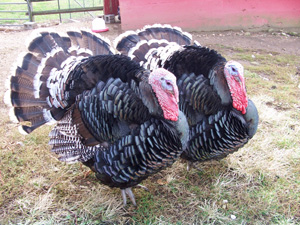 Turkeys have been, by far, the biggest surprise for me. I think I knew what to expect when we began raising the sheep—that they’d be, well, “sheepish.” The goats, frequently portrayed in cartoons eating tin cans, will nibble at just about anything. And chickens? Well, they just act chicken-like.
Turkeys have been, by far, the biggest surprise for me. I think I knew what to expect when we began raising the sheep—that they’d be, well, “sheepish.” The goats, frequently portrayed in cartoons eating tin cans, will nibble at just about anything. And chickens? Well, they just act chicken-like.
But the turkeys? They watch EVERYTHING you do and EVERYTHING that goes on in the barnyard. As young adults, they begin to rely on a precise feeding regimen and know exactly when and where the next feeding should occur.
Our flock is especially sensitive to the sound of heavy truck transmissions and will gobble, in unison, as one approaches. I think they think the school bus is some large yellow bird. Although we can’t see the bus when it’s about a half mile away and approaching, the turkeys begin to gobble and it’s my cue to call the kids. “I hear the turkeys…the bus is coming!”
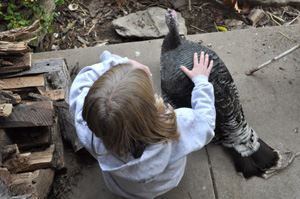
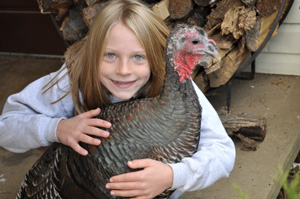 The other morning took the cake. Usually, they will wait on the porch for someone to make their way to the barn for their feeding. I had changed the screen door for the storm door the day before and as I sat at the computer a few feet away, I heard a singular “tap” on the storm door. Then it came again. I waited. There it was again. I went to check it out thinking it was someone’s knock. It was. I opened the door to see the three gobblers, having pecked at the plexiglass, standing on the doormat as if to say, “we’re ready for our corn now.” I laughed out loud—very loud—which started a gobbling reaction from them.
The other morning took the cake. Usually, they will wait on the porch for someone to make their way to the barn for their feeding. I had changed the screen door for the storm door the day before and as I sat at the computer a few feet away, I heard a singular “tap” on the storm door. Then it came again. I waited. There it was again. I went to check it out thinking it was someone’s knock. It was. I opened the door to see the three gobblers, having pecked at the plexiglass, standing on the doormat as if to say, “we’re ready for our corn now.” I laughed out loud—very loud—which started a gobbling reaction from them.
You can only imagine my excitement in visiting Koch’s Turkey Farm and seeing all of those turkeys! Many, many thanks to Duane and the Koch family for a fun visit!
Posted by · Leave a Comment
Join Tracy Toth on a visit to family-owned Koch’s Turkey Farm to learn more about raising antibiotic-free turkeys — including an all-natural vegetarian diet and providing lots of room to roam.
Posted by · 1 Comment
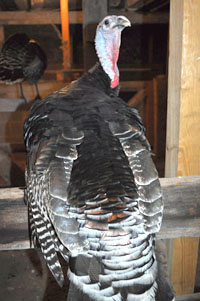
Relaxed Tom
When we began to raise turkeys a few years ago, I had no idea about the “show” they were capable of: the delicate dances, intricate and varietal sounds and calls, and the careful choreography of their mating rituals. Silence does not appear to be in their vocabulary. At any given point during the daylight hours, you can hear the hens and their sharp clucks and the toms gobbling virtually in unison.
Feeding time always brings excitement in the barnyard and the turkeys are no exception—their appearance changes almost instantly!
Unbelievably, the snood (according to the Wild Turkey Federation), which is perched atop the beak, has no known function. It will redden and engorge when the tom is excited and shrink to less than an inch and return to a shade of blue when the tom is relaxed.
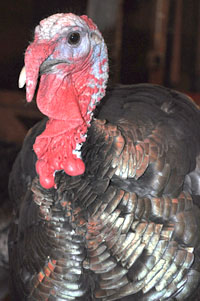
Engorged snood, caruncles and dewlap
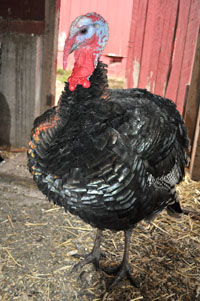
Excited over feeding time
The “caruncles” are bulbous appendages which appear on the neck and head and the dewlap is the skin which connects the underside of the beak to the neck (both sexes). On toms, both of these areas redden and the caruncles will enlarge when strutting or acting aggressively.
Toms possess a somewhat modified feather called a “beard” which protrudes from the center of the breast. It grows three to five inches a year.
As you can imagine, the toms will put on quite the display with their shades of red and magnificent plumage. Do you know when it came time to make the Big Bird costume on TV’s Sesame Street, they reached for white turkey feathers and died them yellow?
The turkey: a natural showstopper!